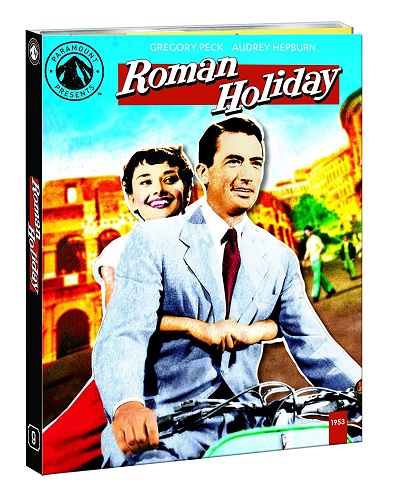
Roman Holiday
Studio: Paramount Presents
Nov 05, 2020
Web Exclusive
![]()
Few films earn their status as “classics” with quite as much ease as William Wyler’s Roman Holiday. A foundational text of the romantic-comedy sub-genre, the film also features the debut of one of the last true Hollywood icons in the form of Audrey Hepburn. It was also a milestone in the shift from stage-bound Hollywood productions to the location shooting that would increasingly characterize modern filmmaking.
With narrative ancestors as old as fairy tales and descendants as varied as tween-targeted Olson Twin vehicles, Roman Holiday features as a premise as fanciful as it is charming. A young princess on a European goodwill tour, Ann finds herself chaffing against the pressures and boundaries of her station. Escaping her attendants, she disguises herself as an ordinary woman to seek adventure on the streets of Rome. She crosses paths with Joe Bradley, a cynical American reporter who sees her as the chance for the biggest story of his career. Deceptions, misunderstandings and romance ensue.
The simple set-up is animated by the charming specificity and earnestness of the cast and crew. The opening credits read ‘and introducing Audrey Hepburn’, which is partially true; although she’d made several films in her native Belgium, Roman Holiday was her Hollywood debut. Her performance as Princess Ann made her an instant star; she won a Best Actress Oscar for the role and would go on to become an era-defining fashion icon over the following decade. With her elfin beauty and bubbly grace, Hepburn looks every bit the part of a princess. The film’s script leans into the fairy tale aspect, never specifying the country or kingdom from which Ann originates, as though her looks and demeanor are all the justification required for her to be royalty. Although Ann could be seen as ground zero for the Manic Pixie Dream Girl trope, Hepburn’s performance and the film’s script - co-written by Dalton Trumbo - gives the character ample dimension. An early scene in which Ann surreptitiously stretches her feet and loses her shoe beneath an elaborate gown while greeting an endless line of foreign dignitaries, beautifully establishes her poise, playfulness and dissatisfaction before she’s even spoken a word. Later scenes of Ann enjoying the sites and pleasures of Rome are infectious in their child-like excitement.
The role of worldly, street-wise reporter Joe Bradley feels as though it could have been written for Cary Grant, so it’s no wonder that he was offered the part first. He declined, citing the twenty-five year age difference between himself and Hepburn as unbelievable; an ironic stance on his part given that they would play opposite each other in Stanley Donen’s Charade ten years later. The role went to Gregory Peck, - only thirteen years older than Hepburn - who plays Bradley with the same slick irritability that Grant would have likely brought to the role, but with a more believable air of working-class grit. Despite his patrician handsomeness, Peck excelled at projecting a man-of-the-people aura that would culminate in his career-defining role as Atticus Finch in 1962’s To Kill a Mockingbird. Introduced losing his last lira in a poker game, Bradley is a world-weary cynic who comes to love the girl he’s using to get the biggest story of his life. The dynamic is far from original, but Peck is skilled enough at building Bradley’s hardened facade and makes its eventual erosion believable and affecting.
One of the most lauded directors in Hollywood history - 12 Oscar noms for directing and 3 wins - William Wyler also holds the distinction of having directed more Oscar winning performances than any other person with a whopping 14. His skill with actors led Hepburn to Oscar gold on her first nomination, but his craftsmanship goes far beyond working with the cast. Much of the charm of Roman Holiday comes from its titular setting, which Wyler puts front and center. By the early 1950s, the gritty, documentary-style filmmaking of Italian Neo-realism had made its way from the post-war environs of Europe to the American Hollywood machine. While no one would ever think to call Roman Holiday “gritty”, the on-the-ground location shooting brings a realism and genuine sense of place to an otherwise fanciful Hollywood confection. This is particularly visible on Paramount’s new 4K remaster of the film, which gives texture and clarity to not only the ancient Italian architecture, but also the faces and outfits of the extras, most of whom were just workaday Romans going about their business. As much as the film feels like a fairy tale, the location shooting also gives it the feeling of a documentary about Rome in the early 50s.
Current Issue

Issue #72
Apr 19, 2024 Issue #72 - The ‘90s Issue with The Cardigans and Thurston Moore
Most Recent
- Under the Radar Announces The ’90s Issue with The Cardigans and Thurston Moore on the Covers (News) — The Cardigans, Thurston Moore, Sonic Youth, Garbage, The Cranberries, Pavement, Lisa Loeb, Supergrass, Spiritualized, Lush, Miki Berenyi, Miki Berenyi Trio, Emma Anderson, Hatchie, Ride, Slowdive, Velocity Girl, Penelope Spheeris, Terry Gilliam, Gus Van Sant, Ron Underwood, Kula Shaker, Salad, Foals, Semisonic, The Boo Radleys, Stereo MC’s, Pale Saints, Blonde Redhead, Sleater-Kinney, Cocteau Twins, Lucy Dacus, Alex Lahey, Horsegirl, Grandaddy, alt-J, Squid, The Natvral, Wolf Alice, Jess Williamson, Sunflower Bean, Orville Peck, Joel McHale
- 10 Best Songs of the Week: Fontaines D.C., Cassandra Jenkins, Loma, John Grant, and More (News) — Songs of the Week, Fontaines D.C., Cassandra Jenkins, Loma, John Grant, Good Looks, Hana Vu, Belle and Sebastian, Yannis & The Yaw, Strand of Oaks, Home Counties
- Fresh Shares New EP ‘Merch Girl’ (News) — Fresh
- Premiere: LOVECOLOR Shares New Video for “Crazy Love” (News) — LOVECOLOR
- Final Summer (Review) — Cloud Nothings

Comments
Submit your comment
There are no comments for this entry yet.